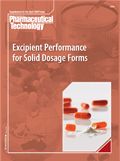News
Article
Pharmaceutical Technology
Roller Compaction of Anhydrous Lactose and Blends of Anydrous Lactose with MCC
The authors studied the behavior of anhydrous lactose and the combination of anhydrous lactose and the combination of anhydrous lactose with microcrystalline cellulose on a pilot-scale roller compactor.
Roller compaction is method of preparing granules for capsules or for tablet formulations. The most common filler–binder excipients used in roller compaction are microcrystalline cellulose (MCC), dibasic calcium phosphate (DCP), and lactose. Studies on the dry granulation of various types of lactose have shown anhydrous lactose to be the best lactose for roller compaction because its brittle nature leads to excellent recompaction properties (1).
Figure 1 is a schematic of the roller compaction process, including the feed hopper from which the formulation mix is fed by the horizontal feed screw (HFS) to the vertical precompression screw (VPS). The VPS deaerates the powder and increases the density of the powder to approximately its tapped bulk density (TBD) just before it is compacted between the two counterrotating rolls. Beneath the rolls the resulting ribbon is milled by the in-line mill to produce the final granulate product.

Figure 1: Schematic of the Chilsonator roller compaction process. HFS is horizontal feed screw; VPS is vertical precompression screw.(all figures are courtesy of the authors.)
The authors investigated the stability of the roller compaction process and the resulting tableting properties of the granules formulated with anhydrous lactose and with combinations of anhydrous lactose and MCC.
Materials and methods
The materials consisted of the following: anhydrous lactose (SuperTab 21AN, DMV-Fonterra Excipients, Nörten-Hardenberg, Germany), MCC (Pharmacel 102, DMV-Fonterra Excipients), and magnesium stearate (BUFA, Uitgeest, The Netherlands).
Roller compaction. Roller compaction was performed with an IR520 Chilsonator machine (The Fitzpatrick Company Europe, see Figure 2) with knurled bevelled rolls fed by a horizontal and a vertical feed screw rotating at ~12 and 200 rpm, respectively. The rolls rotated at the minimum speed of 6 rpm (range 6–22 rpm). The minimum speed was used to best monitor the compaction process. The temperature of the ribbons was measured with an infrared thermometer. Subsequent, in-line milling was performed with the FitzMill model D6A system (The Fitzpatrick Company) that incorporated a knife forward rotor set at a speed of 800 rpm with 1-mm screens (#1532-0040). The time needed to process a certain mass of powder was measured to calculate the throughput of each powder blend at a roll line force of 4.2 kN/cm.

FIigure 2: The Chilsonator IR520 pilot-scale roller compactor (The Fitzpatrick Company Europe).
Particle-size distribution. The particle-size distribution (PSD) of the granules was determined with laser diffraction using a Helos system (Sympatec, Clausthal-Zellerfeld, Germany).
Poured and tapped bulk density. Granule poured and tapped bulk densities were determined using ~230 mL of powder in a 250-mL graduated cylinder. Volume and mass were measured before and after 1250 taps.
Tablet compaction. Granule and powder blends were compacted with a rotary press (Rotab-T, Luxner, Berlin, Germany) equipped with 9-mm flat beveled punches. Tablets weighing 250 mg were produced in all cases.
Tablet-crushing strength. The tablet-crushing strength was tested on 10 tablets the day following compaction.
Tablet friability. Friability was tested in accordance with US Pharmacopeia ‹1210 ›.
Tablet weight uniformity. The relative standard deviation (RSD) of the weight of 10 tablets was calculated.
Results and discussion
Roller compaction. Three placebo blends were roller compacted: 99.25% SuperTab 21AN with 0.75% magnesium stearate; 65% SuperTab 21AN with 35% Pharmacel 102; and 55% SuperTab 21AN with 45% Pharmacel 102. The ribbons did not stick to the roll surface throughout the 20-kg runs. When anhydrous lactose was used as the sole excipient, it was necessary to add some lubricant to prevent the ribbon from sticking to the rolls. The addition of 0.75% magnesium stearate was sufficient. Roller compaction of blends consisting of anhydrous lactose with 35% or 45% MCC required no lubricant to prevent sticking on the knurled roll surface.

Figure 3: Ribbon temperature versus roll pressure. MCC is microcrystalline cellulose; MgSt is magnesium stearate.
The temperature of the ribbons was measured during roller compaction. Rolls were cooled with flowing water at a temperature of 14.6 °C. The temperature of the ribbons rose as the process started but stabilized within 5 min for all three blends. Figure 3 shows the stabilized temperature for the three blends at the five roll pressures. The temperature increased with increasing pressure and was slightly higher for blends containing MCC. Increases in temperature are primarily caused by the densification process of the powder but also by work exerted by the vertical precompression screw. The MCC flows less well than SuperTab 21AN and deforms plastically upon compaction compared with the brittle fracture of SuperTab 21AN. These two differences could be the cause of the temperature elevation.

Figure 4: Particle-size distribution of the SuperTab 21AN 65%, microcrystalline cellulose 35% blend after roller compaction at different pressures and after milling.
A further assessment of the powder blends was made by measuring the throughput. Upon addition of MCC, throughput decreased from 46.0 (0% MCC) to 39.4 (35% MCC) and 41.0 kg/h (45% MCC), which is a reduction of as much as 14%. This decrease was a result of the lower bulk density of the MCC, which shows that at a given roll speed, throughput can be increased by increasing the anhydrous lactose content in the formulation.

Table I: d50 data of the granules.
Granule testing. Ribbons formed by roller compaction were milled into granules. For the purpose of this study, mill settings were kept constant for all formulations and roll pressures. Particle-size analysis showed that as roll pressure was increased, the particle size decreased (see Table I and Figure 4). As the ribbons hardened, the milling intensity of the precompacted material increased, resulting in the production of more fines. Optimizing the mill speed and screen size opening may prevent this effect, but this option was not researched further during this project.

Figure 5: Particle-size distribution (PSD) of the three placebo blends at a roller compactor pressure of 6.3 kN/cm.
Only small differences were observed among the blends. Figure 5 shows that the particle-size distributions of the various blends are similar after compaction and milling under the same circumstances. Figure 6 shows the resulting poured and tapped bulk densities of the granules made from three different blends. Both poured and tapped densities decreased as MCC was added to the blend. As roller pressures increased, the bulk density of the anhydrous lactose granules decreased slightly. and the tapped density remained constant.

Figure 6: Poured bulk and tapped densities of the granules and powder blends (0 kN/cm is the powder blend; AL is anhydrous lactose).
The blends containing MCC displayed different behavior. The bulk density remained constant with increasing pressure, and tapped density increased slightly. The net result was a similar increase in Hausner ratio with increasing compactor pressure for all formulations (see Figure 7).

Figure 7: Hausner ratio versus roll pressure.
Tablet testing. Figure 8 shows the tablet crushing strength of the tablets compacted from the granules. The tablet crushing strength is compared with that of tablets made from powder blend equivalents of the precompacted granules (i.e., blends that were not roller compacted).

Figure 8: Tablet crushing strength of tablets compacted at 5, 10, 15 and 20 kN of the roller compacted granules.
The tablet crushing strength of the tablets increased with increasing compression forces. The granules prepared with 8.4 kN/cm roller compactor pressure capped at compression forces above 10 kN. The tablet crushing strength is, however, more than sufficiently high at this compaction force, as shown in the figure. It was not possible to produce tablets from the granules made at 10.5 kN/cm pressure because of the extremely poor flow of the granules. No attempt was made to improve this situation by adding, for example, a flow agent. The friability of all tablets was low (all below 0.1%). Tablets containing MCC were slightly more robust.
A decrease in tablet crushing strength occurred between powder blends containing MCC and the granules of the same blend. This decrease between non-roller compacted blend and roller compacted granules was not seen with only anhydrous lactose. The tablet crushing strengths of tablets with and without MCC were similar at equivalent compression forces.
The weight uniformity of the tablets (see Figure 9) is best when the blend contains MCC and at the lower roller compaction pressures, which may be a result of granule-flow properties. Again, because tablets were not produced using the granules compacted at 10 kN/cm (because of poor flowability), no results for these tablests are portrayed in the figure.

Figure 9: Weight uniformity relative standard deviation (RSD) of tablets compacted at 5, 10, 15, and 20 kN of the roller compacted granules.
Conclusion
Anhydrous lactose and blends of anhydrous lactose and MCC are highly suitable for roller compaction. There are beneficial and adverse effects of using blends of anhydrous lactose and MCC compared with anhydrous lactose alone. The addition of MCC decreased the throughput of the roller compactor and increased the temperature of the ribbon. However, roller compaction could be performed without the addition of a lubricant when a blend of anhydrous lactose and MCC was used. In addition, including MCC slightly improved the tablet properties with lower tablet friabilities and improved tablet-weight uniformity. On balance, the blend containing 35% MCC was optimal.
Increasing roller compactor pressure resulted in granules with wider particle-size distributions and worse flow. In these studies, where milling was not optimized, a pressure of 4.2 kN provided the best balance between particle-size distibution, flow, and tablet properties.
Sander van Gessel* is a product and business development manager, and Henk van Duinen is a research and development scientist, both at DMV-Fonterra Excipients, Nörten-Hardenberg, Germany, sander.van.gessel@dmv-fonterra-excipients.com. Ivan Bogaerts is a test facility manager at The Fitzpatrick Company Europe, Sint Niklaas, Belgium.
*To whom all correspondence should be addressed.
Reference
1. S. Hein, J. Langridge, and K. Picker-Freyer, "Evaluation of Various Lactose Types and MCC for Roller Compaction," poster presented at the 2007 AAPS Annual Meeting, San Diego, CA.

Newsletter
Get the essential updates shaping the future of pharma manufacturing and compliance—subscribe today to Pharmaceutical Technology and never miss a breakthrough.





